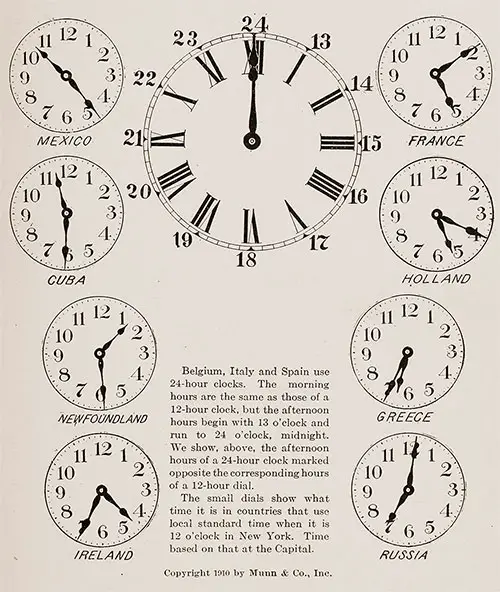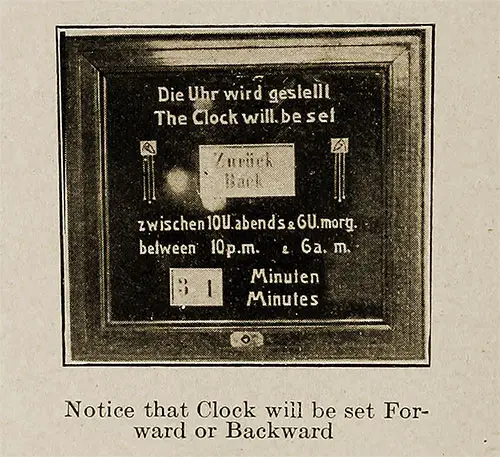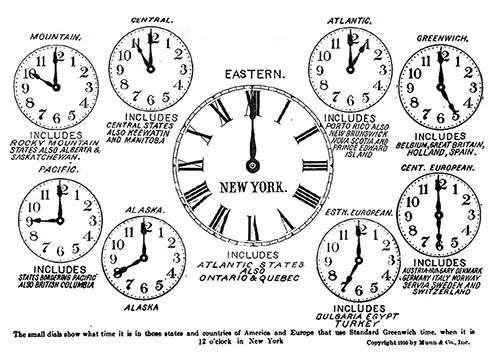Time At Sea – 1910

Belgium, Italy and Spain use 24-hour clocks. The morning hours are the same as those of a 12-hour clock, but the afternoon hours begin with 13 o'clock and run to 24 o'clock, midnight. We show, above, the afternoon hours of a 24-hour clock marked opposite the corresponding hours of a 12-hour dial. The small dials show what time it is in countries that use local standard time when it is 12 o'clock in New York. Time based on that at the Capital. © 1910 by Munn & Co., Inc. GGA Image ID # 17b1499c25

Official Time Clock of an Ocean Liner. Notice That the Clock Will Be Set Forward or Backward. GGA Image ID # 17b16154ba
CHANGE OF TIME
At sea, the ship's time changes daily, and the clocks, which are usually found in the companionways, are corrected. Travelers' watches should be set accordingly as the hours of meals, etc.. are dependent entirely upon these clocks.
HISTORY AND CALCULATION OF TIME
All calculations of time are based on the sun—not the real sun that we see, but a fictitious sun that keeps better time than the real sun.
The time that is indicated by a sundial is the actual Sun Time; but this is not good enough for the civilized world because the day from noon to noon as marked by the real sun is longer at certain times of the year than at others.
However, astronomers have constructed a fictitious sun that gives us days of uniform length, and the time it marks off is called Mean Solar Time. But this does not fully solve the problem of time.
We have still to contend with the fact that the sun reaches the meridian successively later as it progresses westward, so that noon in Chicago, for instance. will be much later than noon in New York.
In fact, noon on the west side of New York would come a few seconds later than noon on the east side. If each town in the country used local mean solar time, the utmost confusion would prevail, particularly on railroads connecting the towns.

The Small Dials Show What Time It Is in Those States and Countries of America and Europe That Use Standard Greenwich Time, When It Is 12 O’Clock in New York. GGA Image ID # 17b16646b6
To avoid this confusion, it has been found necessary to establish certain zones in which uniform time is observed.
It takes the sun twenty-four hours to circle the earth (to be sure, it is the earth that moves, but for convenience, we will consider that the earth is stationary and that the sun is moving around it).
The earth is divided into 360 degrees of longitude. Therefore it takes the sun one hour to traverse 15 degrees of longitude.
The United States and the majority of the European countries have decided to establish time zones approximately 15 degrees wide so that the time of one zone will differ from the next adjacent zones by an even hour.
The degrees of longitude are measured from Greenwich, and at 15 degrees east of Greenwich, the Standard Time used by the surrounding country will be just one hour ahead of Greenwich Time.
Regions in the neighborhood 30 degrees east of Greenwich will use time two hours faster than Greenwich's standard time. The same is true in the westward direction, except that here the clocks will be set slower than Greenwich Time in even hours at intervals of 15 degrees.
Eastern Time is taken from the 75th meridian, which is five times 15 degrees west of Greenwich, making this zone five hours slower than Greenwich Time.
Central Time is taken from the 90th meridian and is one hour slower than Eastern Time and six hours slower than Greenwich Time.
Mountain Time is taken from the 105th meridian and Pacific Time from the 120th meridian. The zones are somewhat distorted, mainly to suit the convenience of railroads.
In Europe, each country is small enough to be included in a single zone.
Greenwich Time is used in Belgium, Great Britain, Holland (railways and telegraph), and Spain.
Central European Time, which is one hour faster than Greenwich Time, is used by Austria-Hungary, Denmark, Germany, Italy, Norway. Serbia, Sweden, and Switzerland.
Eastern European Time, two hours faster than Greenwich, is used by Bulgaria and Egypt. By Europeans, in Turkey, the native time in the last-named country is based on sunset, which is the end of the Turkish day, marks the hour of 12.
In Belgium, Italy, and Spain, the clock dial is divided into twenty-four hours, beginning with 0 at midnight and thus doing away with A. M. and P. M.
A number of European countries have not accepted Standard Time based on the meridian of Greenwich but base their time on a meridian of their own.
For instance, France uses the local mean time of Paris, which is 9 minutes and 21 seconds faster than Greenwich Time.
This is the time that appears outside of railroad stations, but the clocks inside by which the trains are operated are five minutes slower.
Holland clocks are 19 minutes and 32 seconds faster than Greenwich, the time being taken from the Observatory at Amsterdam.
Ireland uses the local Mean Solar Time of Dublin and is 25 minutes and 21 seconds slower than Greenwich.
Portugal takes the local Mean Solar Time of Lisbon, which is 36 minutes and 45 seconds slower than Greenwich.
As in France, railroad time is 5 minutes slower, while The Royal Observatory of St. Petersburg sets the standard for Russia, which is 2 hours 1 minute 19 seconds faster than Greenwich Time.
Were it possible for a person to travel westward around the world as fast as the sun, time would to him appear to be at a standstill?
If he started, say, at noon Monday, it would always be noon Monday to him, and apparently, there would be no change in his calendar. Yet some-where along his course around the world, Monday must have ended, and Tuesday must have begun.
Were the traveler proceeding eastward, he would in 12 hours meet and pass the sun on the opposite side of the earth and would apparently have reached the hour of noon Tuesday.
At the end of 12 hours more, he would meet the sun a second time and would have to tear off another leaf from his calendar and call the time noon, Wednesday.
In other words, his journey around the globe would have taken him two days longer than the man who traveled with the sun and made the trip in no time.
It is a fact that a trip around the earth in a westward direction can actually be made in two days less than a trip in the eastward direction, although the same rate of speed is preserved; but the days of the east-bound traveler would be shorter than those of the west-bound traveler.
In both cases, the travelers would arrive with their calendars one day wrong; but a line has been established running north and south at which travelers are obliged to add a day if they cross it going westward or subtract a day if they cross it traveling eastward.
In other words, the day is supposed to start and end along this line, which is called the International Date Line.
It follows the 180th meridian except for a few digressions, as indicated in the accompanying map, to suit the convenience of inhabitants of islands lying nearby.
TIME AND WATCH ON BOARD SHIP
Watch. For purposes of discipline and to divide the work fairly, the crew is mustered into two divisions; the Starboard (right side, looking forward) and the Port (left). The day commences at noon and is thus divided :
- Afternoon Watch: noon to 4 p. m.
- First Dog Watch: 4 p.m. to 6 p.m.
- Second Dog Watch: 6 p.m. to 8 p.m.
- First Watch: 8 p.m. to midnight.
- Middle Watch: 12 p.m. to 4 a.m.
- Morning Watch: 4 a.m. to 8 a.m.
- Forenoon Watch: 8 a.m. to noon.
This makes seven Watches, which enables the crew to keep them alternatively, as the Watch which is on duty in the forenoon one day has the afternoon next day, and the men who have only four hours' rest one night have eight hours, the next.
This is the reason for having Dog Watches, which are made by dividing the hours between 4 p.m. and 8 p.m. into two Watches.
Time —Time is kept by means of "Bells," although there is but one bell on the ship, and to strike the clapper properly against the bell requires some skill. First, two strokes of the clapper at the interval of a second, then an interval of two seconds; then two more strokes with a second's interval apart, then a rest of two seconds.
Time on board is marked by the ship’s bell being counted as follows:
Name of Watch: Middle Watch
Number of Bells Struck = Hour
1 = 12.30 a.m.
2 = 1.00 a.m.
3 = 1.30 a.m.
4 = 2.00 a.m.
5 = 2.30 a.m.
6 = 3.00 a.m.
7 = 3.30 a.m.
8 = 4.00 a.m.
Name of Watch: Morning Watch
Number of Bells Struck = Hour
1 = 4.30 a.m.
2 = 5.00 a.m.
3 = 5.30 a.m.
4 = 6.00 a.m.
5 = 6.30 a.m.
6 = 7.00 a.m.
7 = 7.30 a.m.
8 = 8.30 a.m.
Name of Watch: Forenoon Watch
Number of Bells Struck = Hour
1 = 8.30 a.m.
2 = 9.00 a.m.
3 = 9.30 a.m.
4 = 10.00 a.m.
5 = 10.30 a.m.
6 = 11.00 a.m.
7 = 11.30 a.m.
8 = Noon
Name of Watch: Afternoon Watch
Number of Bells Struck = Hour
1 = 12.30 p.m.
2 = 1.00 p.m.
3 = 1.30 p.m.
4 = 2.00 p.m.
5 = 2.30 p.m.
6 = 3.00 p.m.
7 = 3.30 p.m.
8 = 4.00 p.m.
Name of Watch: First Dog Watch
Number of Bells Struck = Hour
1 = 4.30 p.m.
2 = 5 p.m.
3 = 5.30 p.m.
4 = 6.00 p.m.
Name of Watch: Second Dog Watch
Number of Bells Struck = Hour
1 = 6.30 p.m.
2 = 7.00 p.m.
3 = 7.30 p.m.
4 = 8.00 p.m.
Name of Watch: First Watch
Number of Bells Struck = Hour
1 = 8.30 p.m.
2 = 9.00 p.m.
3 = 9.30 p.m.
4 = 10.00 p.m.
5 = 10.30 p.m.
6 = 11.00 p.m.
7 = 11.30 p.m.
8 = Midnight
NOTE.—Seven bellt in these two Watches are struck 10 minutes earlier to allow the Watch next for duty to have their breakfast and dinner, respectively. One Bell is also struck at 3.45, 7.45, 11.45 A.M. and P.M. as warning to Watch below, i.e., off duty, to prepare to relieve the deck punctually at Eight Bells.
